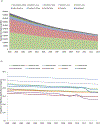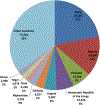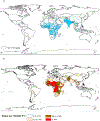Global, Regional, and National Estimates of Rotavirus Mortality in Children <5 Years of Age, 2000-2013
- PMID: 27059362
- PMCID: PMC11979873
- DOI: 10.1093/cid/civ1013
Global, Regional, and National Estimates of Rotavirus Mortality in Children <5 Years of Age, 2000-2013
Abstract
Background: Rotavirus vaccine is recommended for routine use in all countries globally. To facilitate decision making on rotavirus vaccine adoption by countries, help donors prioritize investments in health interventions, and monitor vaccine impact, we estimated rotavirus mortality for children <5 years of age from 2000 to 2013.
Methods: We searched PubMed using the keyword "rotavirus" to identify studies that met each of the following criteria: data collection midpoint in year 1998 or later, study period of a 12-month increment, and detection of rotavirus infection by enzyme immunoassay in at least 100 children <5 years of age who were hospitalized with diarrhea and systematically enrolled through active surveillance. We also included data from countries that participated in the World Health Organization (WHO)-coordinated rotavirus surveillance network between 2008 and 2013 that met these criteria. To predict the proportion of diarrhea due to rotavirus, we constructed a multiple linear regression model. To determine the number of rotavirus deaths in children <5 years of age from 2000 to 2013, we multiplied annual, country-specific estimates of the proportion of diarrhea due to rotavirus from the regression model by the annual number of WHO-estimated child deaths caused by diarrhea in each country.
Results: Globally, we estimated that the number of rotavirus deaths in children <5 years of age declined from 528 000 (range, 465 000-591 000) in 2000 to 215 000 (range, 197 000-233 000) in 2013. The predicted annual rotavirus detection rate from these studies declined slightly over time from 42.5% (95% confidence interval [CI], 37.4%-47.5%) in 2000 to 37.3% (95% CI, 34.2%-40.5%) in 2013 globally. In 2013, an estimated 47 100 rotavirus deaths occurred in India, 22% of all rotavirus deaths that occurred globally. Four countries (India, Nigeria, Pakistan, and Democratic Republic of Congo) accounted for approximately half (49%) of all estimated rotavirus deaths in 2013.
Discussion: While rotavirus vaccine had been introduced in >60 countries worldwide by the end of 2013, the majority of countries using rotavirus vaccine during the review period were low-mortality countries and the impact of rotavirus vaccine on global estimates of rotavirus mortality has been limited. Continued monitoring of rotavirus mortality rates and deaths through rotavirus surveillance will aid in monitoring the impact of vaccination.
Keywords: child mortality; diarrhea; rotavirus.
Published by Oxford University Press for the Infectious Diseases Society of America 2016. This work is written by (a) US Government employee(s) and is in the public domain in the US.
Conflict of interest statement
All authors declare no conflicts of interest.
Figures




References
-
- Vesikari T, Matson DO, Dennehy P, et al. Safety and efficacy of a pentavalent human-bovine (WC3) reassortant rotavirus vaccine. The New England journal of medicine 2006; 354(1): 23–33. - PubMed
-
- Ruiz-Palacios GM, Perez-Schael I, Velazquez FR, et al. Safety and efficacy of an attenuated vaccine against severe rotavirus gastroenteritis. The New England journal of medicine 2006; 354(1): 11–22. - PubMed
-
- Rotavirus vaccines:an update. Releve epidemiologique hebdomadaire / Section d’hygiene du Secretariat de la Societe des Nations = Weekly epidemiological record / Health Section of the Secretariat of the League of Nations 2009; 84(50): 533–40. - PubMed
-
- Patel MM, Glass R, Desai R, Tate JE, Parashar UD. Fulfilling the promise of rotavirus vaccines: how far have we come since licensure? The Lancet infectious diseases 2012; 12(7): 561–70. - PubMed
-
- Richardson V, Hernandez-Pichardo J, Quintanar-Solares M, et al. Effect of rotavirus vaccination on death from childhood diarrhea in Mexico. The New England journal of medicine 2010; 362(4): 299–305. - PubMed
Publication types
MeSH terms
Substances
Grants and funding
LinkOut - more resources
Full Text Sources
Other Literature Sources
Medical
Miscellaneous

